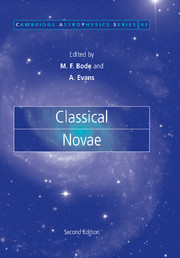Book contents
- Frontmatter
- Contents
- List of contributors
- Preface to the first edition
- Preface to the second edition
- List of symbols
- 1 Novae: an historical perspective
- 2 Properties of novae: an overview
- 3 The evolution of nova-producing binary stars
- 4 Thermonuclear processes
- 5 Nova atmospheres and winds
- 6 Observational mysteries and theoretical challenges for abundance studies
- 7 Radio emission from novae
- 8 Infrared studies of classical novae
- 9 Optical and ultraviolet evolution
- 10 X-ray emission from classical novae in outburst
- 11 Gamma-rays from classical novae
- 12 Resolved nebular remnants
- 13 Dust and molecules in nova environments
- 14 Extragalactic novae
- Object index
- Subject index
14 - Extragalactic novae
Published online by Cambridge University Press: 10 October 2009
- Frontmatter
- Contents
- List of contributors
- Preface to the first edition
- Preface to the second edition
- List of symbols
- 1 Novae: an historical perspective
- 2 Properties of novae: an overview
- 3 The evolution of nova-producing binary stars
- 4 Thermonuclear processes
- 5 Nova atmospheres and winds
- 6 Observational mysteries and theoretical challenges for abundance studies
- 7 Radio emission from novae
- 8 Infrared studies of classical novae
- 9 Optical and ultraviolet evolution
- 10 X-ray emission from classical novae in outburst
- 11 Gamma-rays from classical novae
- 12 Resolved nebular remnants
- 13 Dust and molecules in nova environments
- 14 Extragalactic novae
- Object index
- Subject index
Summary
Introductory remarks
Observations of extragalactic novae date back to the early twentieth century, and were influential in the debate concerning the nature of the spiral nebulae (see van den Bergh (1988) for a review of the early history). Initially, the identification of extragalactic novae was fraught with confusion, as the distinction between classical novae, with typical absolute magnitudes ranging from Mpg ∼ -7 to Mpg ∼ -9, and supernovae, which are of order ten thousand times more luminous, was not yet appreciated. The best-known example of this confusion concerns the report by Hartwig (1885) of a ‘nova’ in the great nebula in Andromeda. This object, S And, is now recognized as the first and only supernova to be observed in M31. Just a decade later another bright star was discovered very near the spiral nebula NGC 5253 by Fleming during her examination of Draper Memorial photographs (Pickering & Fleming, 1896). This object, Z Cen, is also now recognized as a supernova (SN 1895B). No additional nova candidates were associated with spiral nebulae until the discovery on 19 July 1917 by Ritchey (1917a) of a 14th-magnitude transient star in the outer portion of NGC 6946. This discovery set off a systematic search of archival plates from the Mt Wilson 1.5 m reflector dating back to 1908.
- Type
- Chapter
- Information
- Classical Novae , pp. 335 - 359Publisher: Cambridge University PressPrint publication year: 2008
- 14
- Cited by

